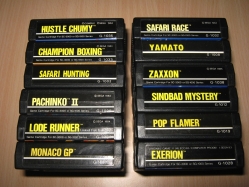
Autopsy:
Hello everyone, after the Fabio D. Bovelacci donation, i have decided to looking around for some cartridges for my Sega SC-3000. As you can see! i have found something.
The games cartridges are Japanese, but it works perfectly with my Sega SC-3000 PAL version.
Sega SC-3000 games cartridges (JAP):
- Safari Race
- Monaco GP
- Zaxxon
- Safari Hunting
- Sinbad Mystery
- Yamato
- Pop Flamer
- Pachinko II
- Lode Runner
- Hustle Chumy
- Exerion
- Champion Boxing
source: sc-3000.com
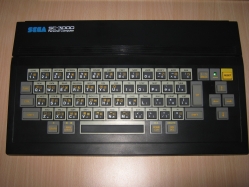
Autopsy:
Many thanks to Fabio D. Bovelacci for his donation. This is my second computer (ZX-81 is the first one), i spent a significant portion of my childhood in front of this one.
from old-computers.com homepage:
The SC-3000 is a computer based on the hardware of the first videogame systems released by Sega in Japan : the SG-1000 series. It can use the same game cartridges marketed for these consoles.
The SC3000 can’t be used without a ROM cartridge, which can be either a game or language. There were three different BASIC cartridges. One came with only 1Kb of RAM (and you had only 512 bytes free !), the second with 16Kb and the last with 32Kb. In official adverts, they show a total RAM of 48Kb. This was counting the VRAM and the 32Kb BASIC cartridge…
Several great games were adapted by Sega for this computer. Several graphic characteristics of the SC-3000 are fairly close to MSX ones. For example, it was one of the first computers to offer 32 sprites. Some months later, Sega released the SC-3000 H which was the same system but with a mechanical keyboard.
This computer was also marketed by Yeno under the same name (Yeno SC 3000 & SC 3000H). It was exactly the same computer except for the Yeno brand…
source: old-computers.com sc-3000.com
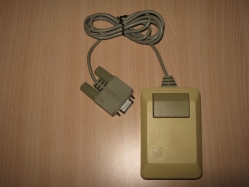
Autopsy:
Many thanks to Nilo for the Apple IIc Mouse.
Apple Inc. is responsible for the mouse interface standard used by today’s computers.
Apple did not invent the mouse, but just like Apple’s popularization of the graphical operating system, the company made the mouse a fundamental part of the personal computer. The Apple mouse has been evolving since the early days of Lisa and Apple II.
Finally i had time to finish the enhancements of my Commodore 64, below a brief description of what you see in the photos.
Enhancements description:
- 1541-III bulk version.
- Reset Switch.
- Multi Kernel with Atmel flash rom.
- Multi Kernel Switch.
- Eprom homebrew PLA.
- Cartridge ON/OFF Switch.
- DualSID with separate output (6581 / 8580)
- 2 x Fan Cooling.
- Fan Cooling Switch.
- Bright Blu Power LED.
- 1541 Ultimate REV1 with v2.0 Firmware.
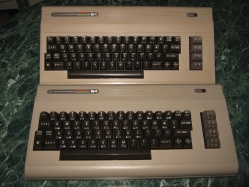
Autopsy:
Today i picked up two Commodore 64, both are in poor condition and Broken.
The first one with the chip SID 6581 can play a garbled sound and the closing hooks broken, the other one with the chip PLA 906114, 7406, CIA 6526 dead. I made some cleaning and repaired the problems.
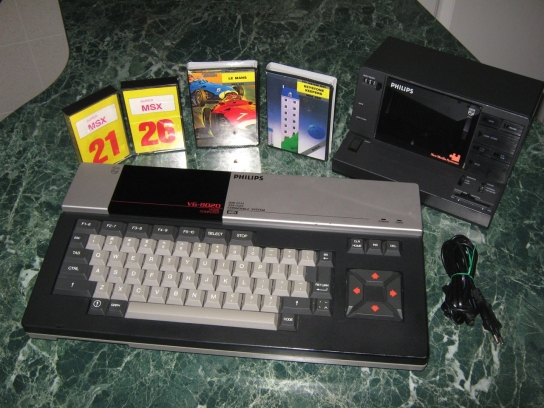
Autopsy:
MSX was the name of a standardized home computer architecture in the 1980s conceived by Kazuhiko Nishi, then Vice-president at Microsoft Japan and Director at ASCII Corporation. It is said that Microsoft led the project as an attempt to create unified standards among hardware makers.
from Wikipedia:
On 27 June 1983, the date considered the birthday of the MSX standard, the MSX was formally announced during a press-conference, and a slew of big Japanese firms declared their plans to introduce machines. The Japanese companies avoided the intensely competitive US home computer market, which was in the throes of a Commodore-led price war.
Only Spectravideo and Yamaha briefly marketed MSX machines in the US. Spectravideo’s MSX enjoyed very little success, and Yamaha’s CX5M model, built to interface with various types of MIDI equipment, was billed more as a digital music tool than a standard personal computer.
source: wikipedia
With great pleasure I found two photo of xad (me) and The Ripper on the Amiga magazine: Eurochart by Crusaders.
- The Ripper of Nightfall on Crusaders Eurochart #13
- Xad of Nightfall on Crusaders Eurochart #14

DualSID KIT by Tomi Malinen:
DualSID is a device which allows you to plug in two different SID models to your Commodore 64.
You can set the second SID‘s address to five different memory locations. For more information and price visit the Tomi Malinen homepage
Download: DualSID V3 PCB Scan (628)
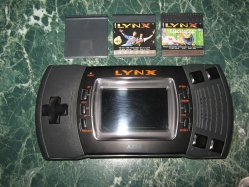
Autopsy:
Thank to Lynx of Nightfall for your generous donation.
The Atari Lynx has several innovative features including its being the first color handheld, with a backlit display, a switchable right-handed/left-handed (upside down) configuration, and the ability to network with up to 17 other units via its “ComLynx” system (though most games would network eight or fewer players).
from Wikipedia:
The Atari Lynx is a 16-bit handheld game console that was released by Atari Corporation in 1989. The Lynx holds the distinction of being the world’s first handheld electronic game with a color LCD. The system is also notable for its forward-looking features, advanced graphics, and ambidextrous layout. The Lynx was released in 1989, the same year as Nintendo’s (monochromatic) Game Boy.
However, the Lynx failed to achieve the sales numbers required to attract quality third party developers, and was eventually abandoned. Today, as with many older consoles, there is still a small group of devoted fans, creating and selling games for the system.
source: wikipedia
I had to make this change to get the Expansion Ram 320XL running on my Atari 800XL:
source: atariage.com
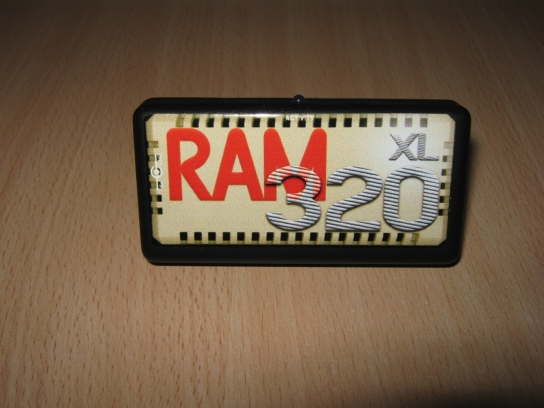
Autopsy:
The Expansion Ram 320XL is a external plug and play 320kB memory expansion card for Atari 600XL and 800XL machines designed by ctirad a user of AtariAge Forum.
Additionally there is a possibility to disable internal memory and remap it onto card (switchable via jumper), thus one can “fix” many failing XLs without even looking inside. Also, an unexpanded 16kB 600XLs can be upgraded to 320XL without any additional work.
The Expansion Ram 320XL uses banking via bits 2,3,5,6 and 4 of PORTB. As you can see this is compatible with “Atari magazine” expansion rather than a most common RAMBO or Compy shop setup, however I have to say the comaptibility with both old and new software is excellent. There can be only problem with some programs, which does use the separate Antic/CPU banking.
The Installation is very easy. The Atari 600XL users will just plug it into PBI port. For Atari 800XL is a bit more complicated, because Atari decided to remove 5V power from the PBI connector from it. Thus 800XL users will have either to use additional power cable which will fit into joystick port or solder one wire inside atari to make the PBI port powered like on 600XL (look photo).
For more information and price visit the atariage.com.
source: atariage.com
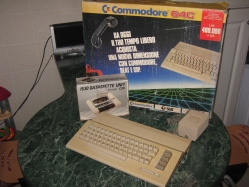
Autopsy:
Today i picked up a Commodore 64c Family Pack Edition with Powersupply / Datasette & Joystick in good working condition. The plastics of the Commodore 64c and Datasette are little yellowed but does not affect the right use.
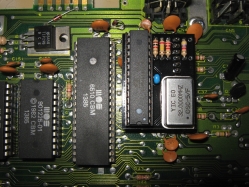
Micro SwinSID KIT by Peter Sieg:
Certainly you can’t expect perfect emulation, but we are very close, the audio is much more clean than the original SID chip, if the project continues on this road we will arrive very soon on the perfect emulation.
Micro SwinSID (SwinSID88) is a hardware replacement for legendary SID sound chip which was placed in every Commodore C64 computer.
This project is based on the microcontroller ATMEGA88PU from Atmel and the emulation code is written by Swinkels. The first version of the pcb (prototype) was made by Crisp.
For more information and price visit the forum64.de.
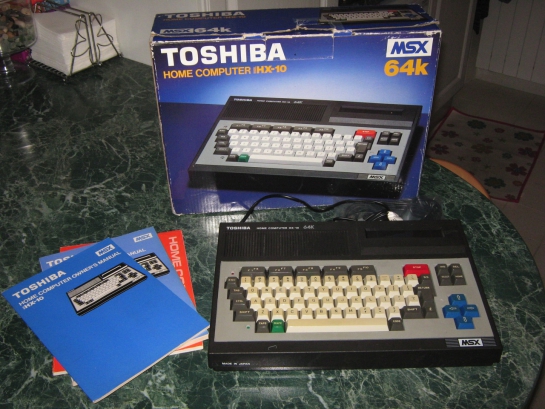
Autopsy:
from Wikipedia:
MSX was the name of a standardized home computer architecture in the 1980s conceived by Kazuhiko Nishi, then Vice-president at Microsoft Japan and Director at ASCII Corporation.
On 27 June 1983, the date considered the birthday of the MSX standard, the MSX was formally announced during a press-conference, and a slew of big Japanese firms declared their plans to introduce machines. The Japanese companies avoided the intensely competitive US home computer market, which was in the throes of a Commodore-led price war.
Only Spectravideo and Yamaha briefly marketed MSX machines in the US. Spectravideo’s MSX enjoyed very little success, and Yamaha’s CX5M model, built to interface with various types of MIDI equipment, was billed more as a digital music tool than a standard personal computer.
source: wikipedia
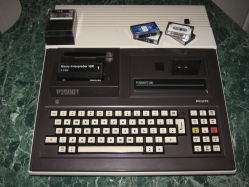
Autopsy:
from Wikipedia:
The Philips P2000T home computer was Philips’ first real entry in the home computer market, after the Philips Videopac G7000 game system (better known in the U.S. as the Magnavox Odyssey2) which they already sold to compete with the Atari 2600 and similar game systems.
There was also an P2000M version with an additional 80-column card for use with a monochrome monitor. This version shipped with a monitor cabinet also housing a dual 5.25″ floppy drive. Basically the P2000T was a Z80 based home computer that used a Teletext display chip to produce the video picture and a small Mini Cassette recorder for mass storage (42 kByte).
 The mini cassette was seen as a floppy drive from the user perspective using the automatic search for a program (CLOAD command) or free space (CSAVE). A command to display the directory of the cassette does also exist. Philips used components they already produced for other markets (television sets and dictation machines) to quickly design a small computer system. It was partially designed by Austrian professor Dieter Hammer.
The mini cassette was seen as a floppy drive from the user perspective using the automatic search for a program (CLOAD command) or free space (CSAVE). A command to display the directory of the cassette does also exist. Philips used components they already produced for other markets (television sets and dictation machines) to quickly design a small computer system. It was partially designed by Austrian professor Dieter Hammer.
They also copied the ROM cartridge system from their Videopac G7000 game system. One of these cartridges contained Microsoft BASIC. It was also possible to use cassette tape floppys.
source: wikipedia

















































































































































































 The mini cassette was seen as a floppy drive from the user perspective using the automatic search for a program (CLOAD command) or free space (CSAVE). A command to display the directory of the cassette does also exist. Philips used components they already produced for other markets (television sets and dictation machines) to quickly design a small computer system. It was partially designed by Austrian professor Dieter Hammer.
The mini cassette was seen as a floppy drive from the user perspective using the automatic search for a program (CLOAD command) or free space (CSAVE). A command to display the directory of the cassette does also exist. Philips used components they already produced for other markets (television sets and dictation machines) to quickly design a small computer system. It was partially designed by Austrian professor Dieter Hammer.


Recent Comments